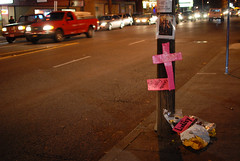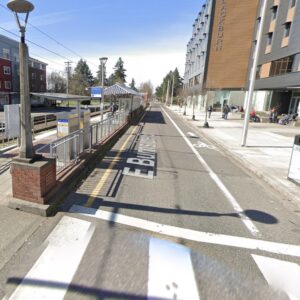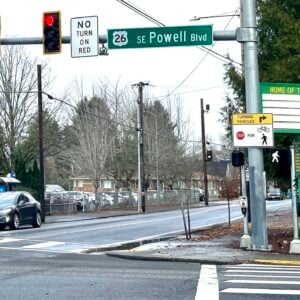The Portland Bureau of Transportation (PBOT) has been doing “crosswalk enforcement actions” for several years. The events, which place a human decoy in a crosswalk with a phalanx of cops waiting to pull people over nearby, have helped raise awareness for crosswalk laws and traffic safety in general. In the past six years, the actions have netted nearly 1,000 citations.
One of the most dangerous streets in the city is SE Foster Road. It’s a high-speed arterial that has claimed many victims over the years, including a fatal hit-and-run just last week. Portland Mayor Sam Adams himself launched a safety campaign on SE Foster in 2010, calling it a de facto “freeway.”
Today I noticed that PBOT had a crosswalk enforcement action scheduled for tonight on SE Powell at 54th — a location less than a mile from SE Foster. In an email from PBOT traffic safety staff about the actions, I read this:
“The crosswalk enforcement action scheduled for Thursday, February 2nd… has been postponed until a later date to be respectful to the residents of Foster Powell and Mt. Scott Arleta that will be having a candlelight vigil for Jason Lee Grant on Thursday at 5:30 PM on SE Foster near SE 71st Avenue. Mr. Grant was crossing SE Foster near SE 71st on Saturday evening when he was struck and killed by a hit and run driver.”
These arterial streets are so frustrating and so sad. Despite efforts to hang banners over them, install blinking lights at crosswalks, do enforcements actions, and hold vigils to remember their victims — these streets continue to win in the end.
Surely there’s got to be more we can do to tame these streets? What we’re doing now is great; but sometimes it seems like it’s just not enough.
For more information about tonight’s candlelight vigil, contact Christian Smith via email at christianbsmith [at] me [dot] com.








Thanks for reading.
BikePortland has served this community with independent community journalism since 2005. We rely on subscriptions from readers like you to survive. Your financial support is vital in keeping this valuable resource alive and well.
Please subscribe today to strengthen and expand our work.
Car ownership conveys entitlement. This is deeply embedded in our cultural experience. And our laws, lack of enforcement, peer pressure, etc. all reinforce this. I had no idea about the extent of this before I became a regular bikeportland reader. Thanks!
Exhibit A: pickup truck driver runs over and kills person on bicycle in Polk Co. No charges. Rural paper reports on this.
Exhibit B: Man flails around with light sabers in toy store – gets 45 days in jail. Oregonian reports on this but not on Exhibit A.
Both from a few days ago.
Or likewise:
Bus rider injured when bicyclist runs stop sign: OregonLive commenters up in arms about cyclists
Bur rider injured when SUV strikes bus: No responses.
I noticed on Sunday that the classified section of the Oregonian is primarily made up of 1/4 page ads for automobile dealerships. Draw your own conclusions.
Mid century arterial highways such as this one are great opportunities for road diet conversions. It is a shame that it is taking so long to make them safer. They are on the Cities wish list but with each pedestrian crash it becomes a tragedy.
An initial high speed limit combined with the 11-14 mph “buffer” given to drivers is a crucial ingredient in this recipe for tragedy.
It’s such an intractable problem mainly because our society is choosing this. For most people who form the base of the economic pyramid, there’s probably some unawareness of negative consequences like these, and/or habituation to the car lifestyle, and/or ignorance (intentional or un-) of the other methods/ways of transport that are out there. So arguably it’s not really a conscious choice, but then again, I somehow found out all the info and did all the work to get to where I’m at now.
Meanwhile those at the top of the pyramid, profiting off the status quo and calling most of the shots, not only choose this, but do everything they can to further the above ignorance and habituation. And finally, for a lot of managers in the middle, a certain number of fatalities is just one of the accepted risks of the system. Just in case you weren’t depressed enough already.
In all 3 cases I’d say it’s a choice, for which I hold the chooser at least partly responsible. So in a way, none of these deaths are accidents. What can you do? Continue to get the word out and continue to serve as an example of another way of doing things.
What does this sentence mean?
…”these streets continue to win in the end.”
I think I get it but clarification of understanding. There’s insight in the answer here culturally I think.
Thanks for covering this, Jonathan. The people in the Foster area have been asking the same questions you pose for a long time.
There’s been a plan approved by the City Council in 2003, and an expansion of the URA five years ago that was explicitly sold on the pledge that the plan would finally be implemented.
Yet on the ground, nothing.
It’s beginning to feel like “traffic safety” is really just code for “full employment for planners and middle managers at PDC.”
The neighborhoods were recently informed that there’d need to be a new plan (!) and a new citizen involvement process –which essentially throws all the previous public involvement processes out the window.
This issue has become a continuing disgrace for the supposed “City that Works.”
What needs to happen is that the project be taken away from PDC and finally given to a project implementation team at PBOT. Money’s finally been identified, and although probably inadequate for everything the plan anticipates, it’s certainly enough to act on long-awaited traffic calming and safety measures. To the extent that there’s a need for additional process, a compact CAC of people from the affected area can act quickly, working directly with PBOT staff.
There’s not a single good reason to wait –except beaurocratic inertia, agency turf-squabbling and pure lack of concern by our failed city leadership.
It’s all getting pretty old and I really don’t want to have to write this again for the next vigil, and next and the next…
John Mulvey
I always wonder why there aren’t more pedestrian lights installed. I’m sure they are not cheap but certainly worth the cost when you consider lives are literally on the line. They don’t hold up traffic unless activated and provide safety for pedestrians. Can’t the city buy a whole bunch and get some kind of discount on the lot? Imagine Foster with one of these every couple blocks.
I’m positive I could make a basic flashing light that could be triggered at a crossing by a pedestrian for next to nothing from Radio Shack. Maybe it’s time to rig something up. At least it might get the cities attention.
sad.
Those new flashers can be installed for $50,000 or so each. Let’s blanket Foster from Powell to Lents with them, lower the speed limit, and see what the effect is. It seems like PBOT is trying but doing way too little.
Even the flashers don’t work. I live near Flloyd Light off SE Stark and 108th. I’ve seen too many close calls and scofflaws. Worst is when a driver stops… and the person behind them whips around into the second lane and continues through the crosswalk. Dangerous.
Even worse is talking to the lady in the SUV who did just that and put a 7th grader on the ground. She felt horror – like she’d just killed one of her kids. Didn’t kill him, thank god, he’ll be set for life financially, yay. He didn’t want to play baseball anyway.
But the lady has to live with what she did. She was so confused, yet knows she did something she wasn’t supposed too – yet EVERYONE does it… we drive, we’re impatient, we adopt behaviors we witness. We want to GET THERE. I forgave her on the spot.
The flashers were on, the crosswalk marked – school kids everywhere and she just… didn’t… see… him.
Didn’t see him.
Bout 4 years back… On SE 122nd and Main – Lit crosswalk, flashers… my wife stopped for a pedestrian when she was 6 mos. pregnant with my 3 year old in the back seat. Her reward? Rear ended and a lifetime of chiropractic treatment.
Hit and run of course. Red honda… we knew because he left part of his bumper in my muffler.
Foster just sucks, period. I lived out there three years ago, and never got over that jittery feeling whenever I’d get off the bus and have to cross. If it was at night, it felt like a death trap.
There’s the obviously ubiquitous speeders, who treat it as a interstate more than an urban thoroughfare. It’s impossible to accurately gauge closing speed most of the time… and the road is incredibly wide, which exacerbates that issue… because you find yourself taking way longer to cross than you’re used to on a street that is in the middle of a city.
Second of all, you can go ten blocks at some points without either a crosswalk or a light. That’s if you have the guts to use the crosswalk at night, unlit, etc.
There shouldn’t be a day that goes by where multiple citations are written in this town for violations around cross walks. I had to record a statement the other day because I witnessed a pedestrian get hit on SW Barber in the new cross walk around milepost 2 or 3 headed out of town in a 45mph zone. I feel like our city/state is being complacent with enforcement.
I’ve asked before… what stands in the way of dramatically increased enforcement and the revenue that would result?
Part of it is cultural… Decision makers and cops mostly drive so they lack the intimate sensitivity/sense of urgency to these traffic safety issues.
But a bigger part is practical in that the PPB is very strapped for resources and – related to the cultural issue above – improving traffic safety isn’t their highest priority.
I’ve been thinking about this more, and I am convinced that with imagination and a sufficiently concentrated legal and accounting study, a model can be conceived whereby traffic citation revenue funds traffic enforcement.
I am also starting to think that if it could be achieved successfully, it would fundamentally change the safety of our transportation system.
I understand the fear/suspicion of creating an opportunity for corruption, but I think that’s avoidable. It seems to me that a successful model has to eliminate any direct incentive for a patrol officer to write frivolous citations–such a plan would need:
– to disconnect the ticket-writer and his chain of command from the citation revenue stream.
– laws and other controls that assure that citation revenue is always and only channeled to, specifically, traffic enforcement staffing
– unprecedented public transparency of the flow of that citation revenue
– legal protection of that revenue stream from other budgetary appetites
Am I just dreaming?
What I mean is, isn’t there a model whereby increased enforcement is ultimately self-funded?
And I get what you’re saying, Jonathan, about the cultural hurdle that stands in the way.
Generally traffic fines are specifically NOT returned directly to enforcement agencies because that creates too much incentive to issue more citations. Given that most alleged violations have only the issuing officer and the accused as witnesses we need to avoid any financial reward to departments for issuing more citations.
I live right in the area….from my experience on foster, people do not stop at crosswalks unless there is a green-red-yellow light there. Even with the blinding flashing yellow strobe lights at the Fred Meyer crosswalk, you still get a lot of cars running it. The crosswalks with traditional lights – not saying it doesn’t happen, but its rare to have a car run those. Foster is just a terrible road, it shimmies back and forth, the lanes shift without warning; I avoid it like the plague and ride south to Woodstock or north to Powell.
To my surprise, I’ve found this yellow reflective umbrella, with crosswalk markings, to be effective for me in getting cars to stop at unmarked crossings–I wouldn’t have guessed it:
http://secure.4imprint.com/imageserver/productimages/4imprint/super_detailed/100675.jpg
Agreed, I don’t understand why this could not be self funded.